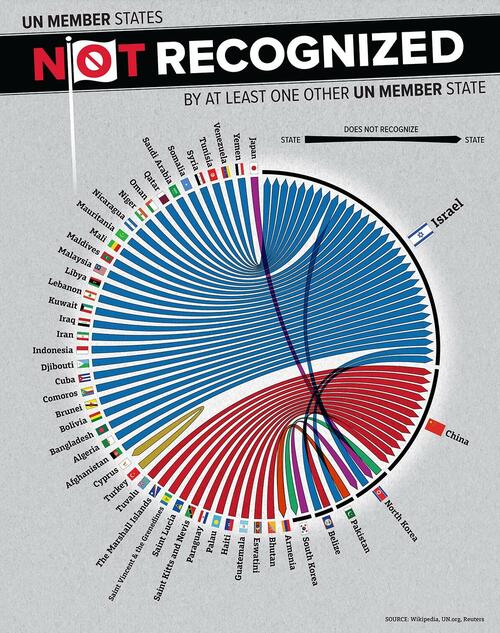
There are currently 193 member states in the United Nations. And despite the UN granting membership by recognizing sovereignty, not all nations recognize each other individually.
This chart by Visual Capitalist's creator Julie Peasley, breaks down the complex geopolitics at play. To read it: follow the arrow from one country to the other UN member that they do not recognize.
The creator chose to limit this visualization to UN member states only and not include:
- Observer states (i.e. Palestine)
- Partially recognized states (i.e. Kosovo, Cook Islands, Niue)
- Countries not recognized by the UN (i.e. Taiwan, Western Sahara)
The Murky Waters of International Relations
A brief glance at the chart shows two countries drawing the most diplomatic ire: China and Israel.
Briefly speaking, many Pacific and Atlantic islands do not recognize China, and most of the Muslim world doesn’t recognise Israel.
| UN Member State | ❌ Does Not Recognize |
|---|---|
| 🇵🇰 Pakistan | 🇦🇲 Armenia, 🇮🇱 Israel |
| 🇧🇿 Belize | 🇨🇳 China, 🇮🇱 Israel |
| 🇧🇹 Bhutan | 🇨🇳 China |
| 🇸🇿 Eswatini | 🇨🇳 China |
| 🇬🇹 Guatemala | 🇨🇳 China |
| 🇭🇹 Haiti | 🇨🇳 China |
| 🇰🇳 Saint Kitts and Nevis | 🇨🇳 China |
| 🇱🇨 Saint Lucia | 🇨🇳 China |
| 🇻🇨 Saint Vincent… | 🇨🇳 China |
| 🇲🇭 The Marshall Islands | 🇨🇳 China |
| 🇵🇼 Palau | 🇨🇳 China |
| 🇵🇾 Paraguay | 🇨🇳 China |
| 🇹🇻 Tuvalu | 🇨🇾 Cyprus |
| 🇹🇷 Türkiye | 🇮🇱 Israel |
| 🇦🇫 Afghanistan | 🇮🇱 Israel |
| 🇩🇿 Algeria | 🇮🇱 Israel |
| 🇧🇩 Bangladesh | 🇮🇱 Israel |
| 🇧🇴 Bolivia | 🇮🇱 Israel |
| 🇧🇳 Brunei | 🇮🇱 Israel |
| 🇰🇲 Comoros | 🇮🇱 Israel |
| 🇨🇺 Cuba | 🇮🇱 Israel |
| 🇩🇯 Djibouti | 🇮🇱 Israel |
| 🇮🇩 Indonesia | 🇮🇱 Israel |
| 🇮🇷 Iran | 🇮🇱 Israel |
| 🇮🇶 Iraq | 🇮🇱 Israel |
| 🇰🇼 Kuwait | 🇮🇱 Israel |
| 🇱🇧 Lebanon | 🇮🇱 Israel |
| 🇱🇾 Libya | 🇮🇱 Israel |
| 🇲🇾 Malaysia | 🇮🇱 Israel |
| 🇲🇻 Maldives | 🇮🇱 Israel |
| 🇲🇱 Mali | 🇮🇱 Israel |
| 🇲🇷 Mauritania | 🇮🇱 Israel |
| 🇳🇮 Nicaragua | 🇮🇱 Israel |
| 🇳🇪 Niger | 🇮🇱 Israel |
| 🇰🇵 North Korea | 🇮🇱 Israel |
| 🇴🇲 Oman | 🇮🇱 Israel |
| 🇶🇦 Qatar | 🇮🇱 Israel |
| 🇸🇦 Saudi Arabia | 🇮🇱 Israel |
| 🇸🇴 Somalia | 🇮🇱 Israel |
| 🇸🇾 Syria | 🇮🇱 Israel |
| 🇹🇳 Tunisia | 🇮🇱 Israel |
| 🇻🇪 Venezuela | 🇮🇱 Israel |
| 🇾🇪 Yemen | 🇮🇱 Israel |
| 🇯🇵 Japan | 🇰🇵 North Korea |
Source: Wikipedia.
The China bloc is explained by Beijing’s stance: no state can recognize both the People’s Republic of China and the Republic of China (Taiwan) at the same time.
As a result, all the countries here who don’t recognize China, currently see Taiwan as a sovereign country.
Finally, animosity around Israel’s recognition stems from the ongoing Israel-Palestine conflict. Most Arab nations opposed the partition of the British Mandate of Palestine and invaded Israel, leading to the 1948 war.
At various times, different Arab countries have spoken in favor of normalizing relations, on the condition that Israel withdraw from Palestinian territories.
Julie Peasley is a prolific creator, and placed as runner-up in Voronoi’s Visual of the Year 2024. If you like big visualizations that can be dived into, check out: Political Leaning in the U.S. by Occupation.
There are currently 193 member states in the United Nations. And despite the UN granting membership by recognizing sovereignty, not all nations recognize each other individually.
This chart by Visual Capitalist’s creator Julie Peasley, breaks down the complex geopolitics at play. To read it: follow the arrow from one country to the other UN member that they do not recognize.
The creator chose to limit this visualization to UN member states only and not include:
- Observer states (i.e. Palestine)
- Partially recognized states (i.e. Kosovo, Cook Islands, Niue)
- Countries not recognized by the UN (i.e. Taiwan, Western Sahara)
The Murky Waters of International Relations
A brief glance at the chart shows two countries drawing the most diplomatic ire: China and Israel.
Briefly speaking, many Pacific and Atlantic islands do not recognize China, and most of the Muslim world doesn’t recognise Israel.
| UN Member State | ❌ Does Not Recognize |
|---|---|
| 🇵🇰 Pakistan | 🇦🇲 Armenia, 🇮🇱 Israel |
| 🇧🇿 Belize | 🇨🇳 China, 🇮🇱 Israel |
| 🇧🇹 Bhutan | 🇨🇳 China |
| 🇸🇿 Eswatini | 🇨🇳 China |
| 🇬🇹 Guatemala | 🇨🇳 China |
| 🇭🇹 Haiti | 🇨🇳 China |
| 🇰🇳 Saint Kitts and Nevis | 🇨🇳 China |
| 🇱🇨 Saint Lucia | 🇨🇳 China |
| 🇻🇨 Saint Vincent… | 🇨🇳 China |
| 🇲🇭 The Marshall Islands | 🇨🇳 China |
| 🇵🇼 Palau | 🇨🇳 China |
| 🇵🇾 Paraguay | 🇨🇳 China |
| 🇹🇻 Tuvalu | 🇨🇾 Cyprus |
| 🇹🇷 Türkiye | 🇮🇱 Israel |
| 🇦🇫 Afghanistan | 🇮🇱 Israel |
| 🇩🇿 Algeria | 🇮🇱 Israel |
| 🇧🇩 Bangladesh | 🇮🇱 Israel |
| 🇧🇴 Bolivia | 🇮🇱 Israel |
| 🇧🇳 Brunei | 🇮🇱 Israel |
| 🇰🇲 Comoros | 🇮🇱 Israel |
| 🇨🇺 Cuba | 🇮🇱 Israel |
| 🇩🇯 Djibouti | 🇮🇱 Israel |
| 🇮🇩 Indonesia | 🇮🇱 Israel |
| 🇮🇷 Iran | 🇮🇱 Israel |
| 🇮🇶 Iraq | 🇮🇱 Israel |
| 🇰🇼 Kuwait | 🇮🇱 Israel |
| 🇱🇧 Lebanon | 🇮🇱 Israel |
| 🇱🇾 Libya | 🇮🇱 Israel |
| 🇲🇾 Malaysia | 🇮🇱 Israel |
| 🇲🇻 Maldives | 🇮🇱 Israel |
| 🇲🇱 Mali | 🇮🇱 Israel |
| 🇲🇷 Mauritania | 🇮🇱 Israel |
| 🇳🇮 Nicaragua | 🇮🇱 Israel |
| 🇳🇪 Niger | 🇮🇱 Israel |
| 🇰🇵 North Korea | 🇮🇱 Israel |
| 🇴🇲 Oman | 🇮🇱 Israel |
| 🇶🇦 Qatar | 🇮🇱 Israel |
| 🇸🇦 Saudi Arabia | 🇮🇱 Israel |
| 🇸🇴 Somalia | 🇮🇱 Israel |
| 🇸🇾 Syria | 🇮🇱 Israel |
| 🇹🇳 Tunisia | 🇮🇱 Israel |
| 🇻🇪 Venezuela | 🇮🇱 Israel |
| 🇾🇪 Yemen | 🇮🇱 Israel |
| 🇯🇵 Japan | 🇰🇵 North Korea |
Source: Wikipedia.
The China bloc is explained by Beijing’s stance: no state can recognize both the People’s Republic of China and the Republic of China (Taiwan) at the same time.
As a result, all the countries here who don’t recognize China, currently see Taiwan as a sovereign country.
Finally, animosity around Israel’s recognition stems from the ongoing Israel-Palestine conflict. Most Arab nations opposed the partition of the British Mandate of Palestine and invaded Israel, leading to the 1948 war.
At various times, different Arab countries have spoken in favor of normalizing relations, on the condition that Israel withdraw from Palestinian territories.
Julie Peasley is a prolific creator, and placed as runner-up in Voronoi’s Visual of the Year 2024. If you like big visualizations that can be dived into, check out: Political Leaning in the U.S. by Occupation.
Loading…





